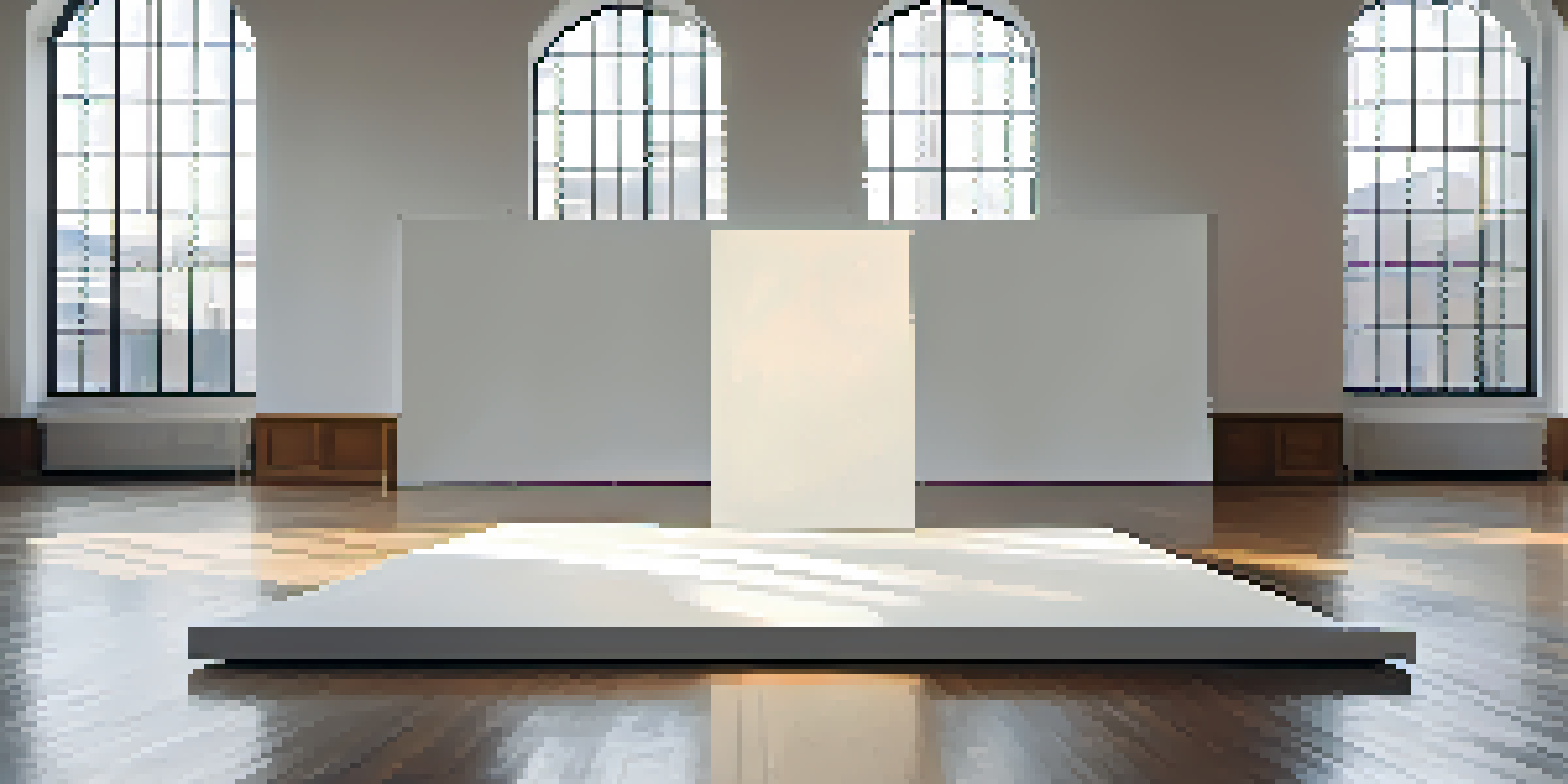The Role of Space and Form in Minimalist Artworks

Understanding Minimalism: A Brief Introduction
Minimalism is an art movement that emerged in the late 1950s, characterized by simplicity and clarity. Artists stripped away the unnecessary, focusing instead on the essence of form and color. This approach invites viewers to engage with the artwork on a deeper level, often prompting introspection.
The ability to simplify means to eliminate the unnecessary so that the necessary may speak.
Unlike more complex art styles, minimalism emphasizes the idea that 'less is more.' By using a limited palette and basic geometric shapes, minimalist artists challenge our perceptions and encourage us to appreciate the subtlety around us. It's an invitation to slow down and really see what is in front of us.
In this exploration, we will delve into how space and form play pivotal roles in creating minimalist artworks, shaping the viewer's experience and understanding of the art itself.
The Significance of Space in Minimalist Art
Space in minimalist art is not just an empty void; it plays a crucial role in the overall composition. Artists utilize negative space—areas without any objects—to create balance and harmony within their works. This intentional use of space encourages viewers to explore the relationship between the artwork and its surroundings.

Consider how a vast expanse of white canvas can evoke feelings of tranquility or isolation. The absence of clutter allows the eye to rest, making the interaction with the artwork more profound. It’s almost like an open invitation to reflect upon one's thoughts and feelings.
Space Enhances Minimalist Art
The intentional use of negative space in minimalist art creates balance and encourages deeper viewer reflection.
By emphasizing space, minimalist artists create a dialogue between the artwork and the viewer, turning the act of observation into an active, contemplative experience.
Form: The Heart of Minimalist Expression
Form is the tangible aspect of minimalist art, encompassing shapes, lines, and colors used in a piece. In minimalist works, artists often rely on geometric forms—such as squares, circles, and triangles—to convey their message. These basic shapes can carry a multitude of meanings depending on their arrangement and context.
Simplicity is the ultimate sophistication.
For instance, a single, bold square can symbolize strength and stability, while a series of intersecting lines might represent connection and movement. Through the thoughtful arrangement of these forms, artists can evoke emotions and ideas, encouraging viewers to interpret the work in their own way.
Ultimately, the simplicity of form in minimalist art allows for a more personal connection, as each viewer brings their own experiences and interpretations to the piece.
The Interaction of Space and Form
The relationship between space and form is where minimalist art truly shines. When form is placed within a thoughtfully considered space, it can create an impactful visual experience. This interaction not only defines the artwork but also dictates how viewers perceive and engage with it.
For example, a lone sculpture positioned in a vast room can evoke a sense of solitude or contemplation, while multiple forms clustered together may create a feeling of community or chaos. The interplay between the two elements encourages a dynamic exploration of the work, drawing viewers into its depths.
Form Communicates Emotion
Geometric shapes and their arrangements in minimalist works convey various meanings, allowing viewers to interpret the art personally.
This synergy is essential in minimalist art, as it transforms simple shapes and spaces into profound experiences that resonate emotionally with the audience.
Cultural Influences on Minimalist Art
Minimalism is not just an aesthetic choice; it's also a reflection of cultural influences. The movement emerged during a time of social and political upheaval, where artists sought to question traditional values and explore new forms of expression. The simplicity of minimalist art can be seen as a reaction to the complexities of the modern world.
For instance, Japanese Zen philosophy, with its emphasis on simplicity and natural beauty, has significantly influenced minimalist artists. This cultural backdrop encourages a focus on the essential and the meaningful, guiding artists to create works that resonate with deeper truths.
By understanding these cultural contexts, we can better appreciate the layers of meaning behind minimalist artworks and their space and form.
The Viewer’s Role in Minimalist Art
In minimalist art, the viewer becomes an active participant in the experience. The open nature of minimalist works invites individuals to bring their interpretations and emotions into the dialogue. This personal engagement is what makes minimalist art so powerful and relatable.
As viewers stand before a minimalist piece, they are often encouraged to reflect on their surroundings, thoughts, and feelings. The absence of explicit narratives allows for a range of interpretations, making each encounter unique and personal.
Viewer Engagement is Key
In minimalist art, the viewer's personal interpretation transforms the experience, making each encounter unique and meaningful.
Thus, the role of space and form stretches beyond the artwork itself, extending into the viewer's mind and encouraging a deeper connection with the piece.
The Impact of Technology on Minimalist Art
In recent years, technology has started to influence minimalist art in fascinating ways. Digital mediums allow artists to experiment with form and space in ways that traditional materials cannot. From digital installations to virtual reality, the boundaries of minimalist art continue to expand.
Artists are now able to create immersive experiences where space and form interact dynamically, engaging viewers in new and innovative ways. For example, virtual reality art can transport individuals into minimalist environments, allowing them to explore the relationship between space and form from different perspectives.

This technological evolution not only enhances the minimalist aesthetic but also challenges our understanding of art itself, pushing us to reconsider how we experience and interpret minimalist works.